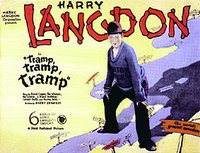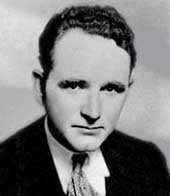
“Tramp!, Tramp!, Tramp!” was an American song very popular in that country during their particular civil war and the perfect excuse for this German count to show in his private silent cinema a double feature with two films with that same name. Of course, this aristocrat prefers to sing patriotic German songs as “Lili Marleen”…
The first one was a Max Fleischer’s animated cartoon produced in 1926.During the 20’s Max Fleischer was ahead of his time (and Walt Disney ) in the creation and development of new techniques in cartoon films, perfecting the“Rotoscope”, a device that enabled animators, frame by frame, to trace character movements from live action film onto animation paper. During those years he created “Ko-Ko”, a kind of animated clown that was very popular with his “Koko Quartet Band” which naturally provided the perfect excuse for singing along with him in many cartoons with the help of a bouncing ball.So picture it: a German aristocrat in his private cinema singing along with an Amerikan song and trying to fall into step with the help of that damned bouncing ball, all without losing one’s Teutonic composure. A very difficult task, certainly…Anyway, the film is a funny divertimento skilfully produced.

The second one was a film directed by Harry Edwards in 1926 too and starred Harry Langdon.The story tells the adventures of Harry ( Herr Harry Langdon ) and his attempt to save his father’s shoemaking business; his father can’t pay the rent to the landlord because he can’t compete with the powerful Joe Burton footwear corporation.This rivalry leads to the creation of a cross-country footrace, the “Burton Cross Country Race” a publicity stunt with a prize of 25.000 dollars, just enough to save Harry’s father shoemaking business. As always, Herr Harry Langdon plays his popular character, a childish, naïve but likeable hero who will be involved in many and complicated adventures .
Sometimes one gets the feeling that nothing much happens with the story in HerrLangdon's slapstick comedies because the actor deliberately takes his time to play slow and care mime scenes as well as setting up intricate and astounding gags like the cliff or the cyclone sequences. One can see the influence of great comedians as Herr Buster Keaton or Harold Lloyd but fortunately Herr Langdon don’t imitate those greats but uses them to enrich his particular style with elaborate and funny sequences. By the way, besides the prize of 25.000 dollars for the winner, at the end of the footrace, Harry will have an extra reward;Damen Betty ( Joan Crawford ), the woman he loves and the perfect excuse to cross not one country but two.
And now, if you'll allow me, I must temporarily take my leave because this German Count must to rest after such a long tramp.
Herr Graf Ferdinand Von Galitzien
-/-
La canción “Tramp!, Tramp!, Tramp!” era una canción americana muy popular en dicho país durante la época de su particular guerra civil y un buen motivo para que éste Conde germánico proyectase una sesión doble en su sala de cine privada, con dos filmes con ese mismo título, no sin antes mencionar que éste aristócrata prefiere muchísimo más cantar canciones patrióticas germánicas como “Lili Marleen”…
El primer filme es un “cartoon” de Max Fleischer producido en el año 1926; durante los años 20, Max Fleischer se adelantó a su tiempo ( y a Walt Disney ) en la creación y desarrollo de nuevas técnicas para los filmes animados, perfeccionando el “Rotoscope”, un aparato que permitía a los animadores, secuencia a secuencia, trasladar los movimientos de los personajes de películas reales a los de animación.
Durante esos años nació “Ko-Ko”, una especie de payaso animado que fue muy popular conjuntamente con su banda, la “Ko-Ko Quarter Band”, permitiendo éstos, con la ayuda de una pelota saltarina, que el público asistente en la sala, cante de viva voz las canciones interpretadas por la banda animada.
Imagínense la escena: un aristócrata germánico en su sala de proyecciones privada cantando esas cancioncillas americanas, intentando no perder el ritmo con la ayuda de esa ordinaria pelota saltarina y todo ello sin perder igualmente la compostura teutona, una tarea ciertamente complicada… en fin, de todas formas este filme animado resulta ser un divertimento hábilmente producido.
El segundo filme fue dirigido por Harry Edwards también en el año 1926 y protagonizado por Harry Langdon.
La historia nos narra las vicisitudes de Harry ( Herr Harry Langdon ) y sus intentos por salvar el negocio de su padre, una zapatería; el padre de Harry no puede pagar el alquiler al casero debido a la poderosa compañía zapateril de Joe Burton con la cual no puede competir; dicha rivalidad dará lugar a la creación por parte del magnate de la “Burton Cross Country Race”, una maratón que atravesará todo el país, una estrategia publicitaria que tendrá como premio para el ganador, la cantidad de 25.000 dólares, más que suficiente dinero éste para salvar la zapatería del padre de Harry.
Como es habitual, Herr Harry Langdon interpreta su famoso personaje ingenuo, infantil e igualmente heroico, que se verá envuelto en varias y complicadas aventuras.
Habitualmente se tiene la impresión de que en las comedias de Harry Langdon nada acontece, debido a lo morosas de muchas situaciones y la tranquilidad con la cual el actor desenvuelve las escenas, aunque de todas formas en éste filme hay que destacar elaboradas y complicados gags como el que sucede en el acantilado o la secuencia del ciclón.
La influencia de grandes cómicos como Herr Buster Keaton o Harold Lloyd es bastante notoria pero afortunadamente Herr Langdon no se limita a copiarlos sino que los utiliza para enriquecer su peculiar estilo gracias a elaborados y divertidos gags.
Por cierto, además del premio de 25.000 dólares, al final de la carrera, Harry tendrá una recompensa extra: Damen Betty ( Joan Crawford ), la mujer a la cual ama y la perfecta excusa no para cruzar a pie un país, sino dos.
Y ahora si me lo permiten les tengo que dejar momentáneamente, pues este Conde germánico tiene que descansar después de tan larga caminata.
Herr Graf Ferdinand Von Galitzien
















